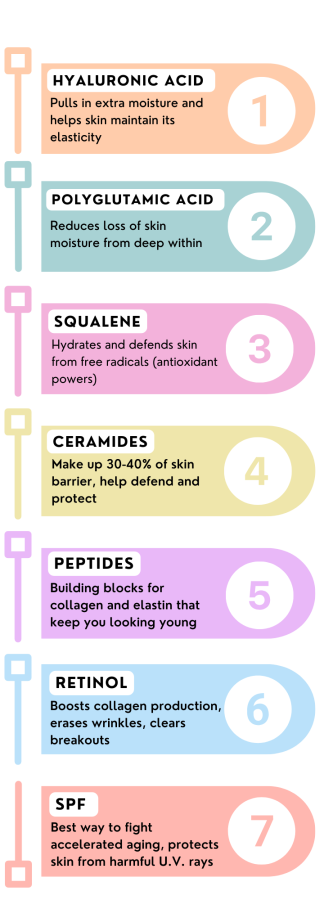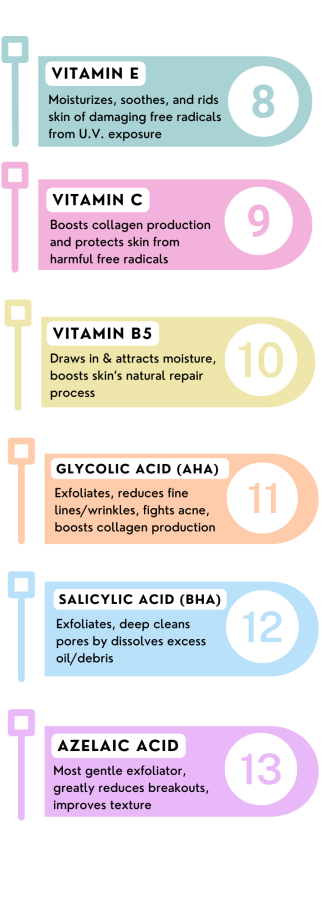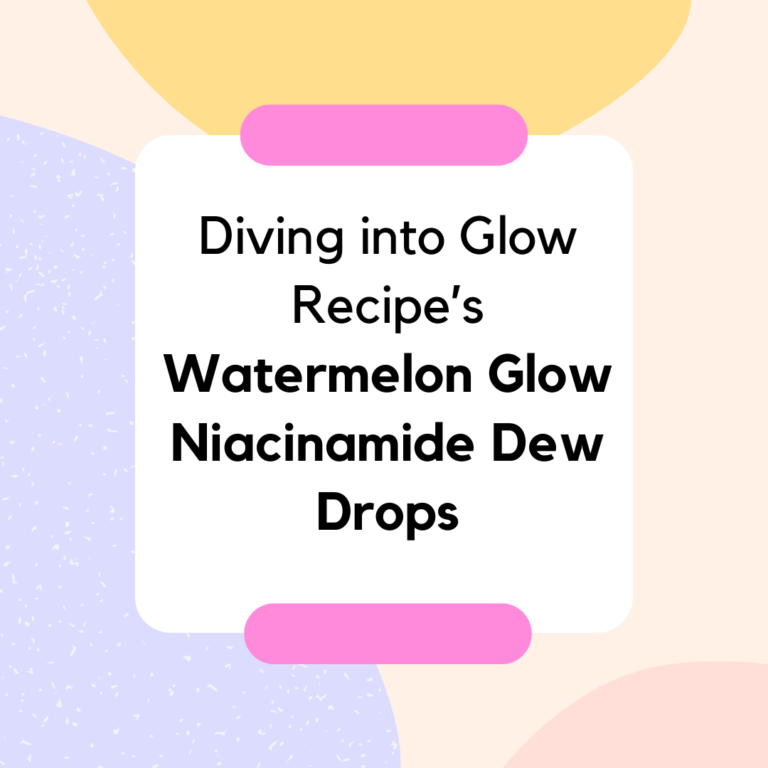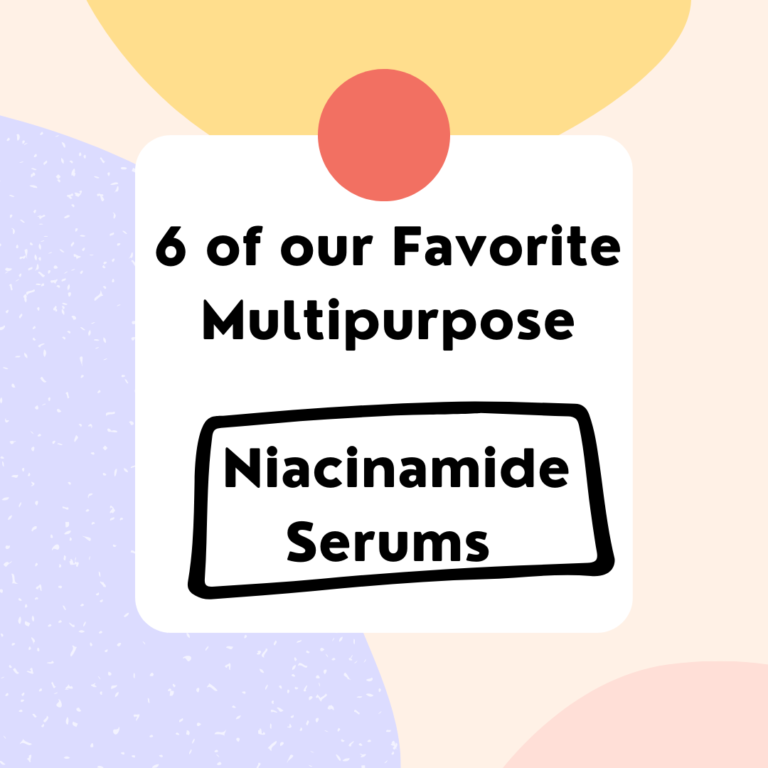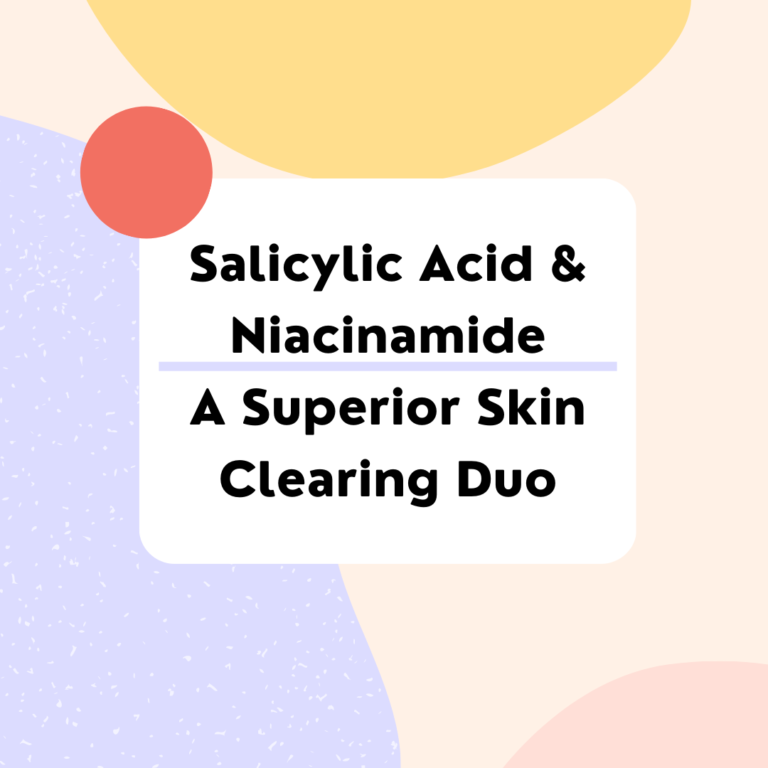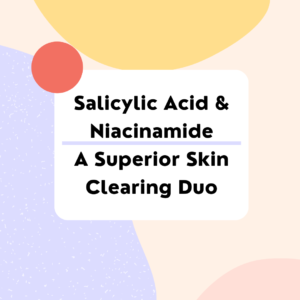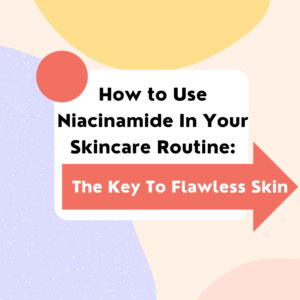You can look online and find countless positive results of niacinamide before and after people incorporate it into their routine, but what about other actives that can help boost its benefits? Niacinamide is a team player and you will find that you can mix it with so many different ingredients to experience added benefits for your skin. This powerful antioxidant has the potential to reduce most negative side effects associated with common highly effective ingredients (like retinol), and can make your overall skincare experience safer and more beneficial. Below is a pretty extensive list of different ingredients you can safely use alongside Niacinamide to build a killer skincare routine!
*Preview: This list covers chemical exfoliants (AHA and BHA), retinol, humectants (hydrating agents), vitamin-rich antioxidants (vitamin C), and notorious barrier strengtheners like ceramides and peptides.
Table of Contents
Toggle1. Hyaluronic Acid
Class: hydration
Hyaluronic acid is a major hydrating agent when it comes to skincare. Able to hold 1000x its weight in water, when you apply HA to the skin it instantly plumps and draws in moisture, revitalizing your complexion. The plumping effect we associate with hyaluronic acid helps to reduce signs of aging and keeps those pesky fine lines and wrinkles away!
This acid is naturally made by the body and serves a crucial role in maintaining your skin’s structure and flexibility. It is also suitable for all skin types and conditions. As we age, our skin loses its natural elasticity which HA helps to restore. Apply to wet skin for best results! HA will pull in the excess moisture left on the face to give you the surge of hydration you need.
–>Read more here about the benefits of combining HA with Niacinamide before and after.
2. Polyglutamic Acid
Class: hydration
Somewhat similar to hyaluronic acid, polyglutamic acid is another super hydrating agent for the skin. Polyglutamic Acid can hold 4,000x its molecular weight in water, and can attract more moisture to the skin from the atmosphere. If you’re looking for a natural, lasting “highlighter” effect similar to glowing makeup then make PA a part of your routine!
Key Differences: Hyaluronic Acid vs Polyglutamic Acid
- Surface Hydration: Polyglutamic Acid is 4X more effective than hydrating the skin {on the surface} in comparison to HA. When you apply PGA, it not only hydrates the skin, but it greatly reduces the loss/evaporation of existing moisture in your skin. Though it can hydrate more effectively on the surface, PGA is heavier from a molecular standpoint which hinders its ability to penetrate deep into the skin. If you’re looking for superior surface hydration, Polyglutamic Acid is a top choice.
- Deep Hydration: Hyaluronic Acid is still highly effective at hydrating the surface skin, but weighs less than PGA from a molecular standpoint. This lighter weight allows HA to dive deeper into the skin and be an effective hydrator from beneath your skin’s surface. When applied, HA will seep into your face and draw moisture deep below the surface and bring up extra moisture to the surface as well to diminish fine lines and wrinkles.
- Think of it like this → PGA focuses all hydrating efforts on surface skin and doesn’t venture below the surface at all. On the other hand, HA splits its attention and focuses primarily on pulling in much needed moisture and sort of hydrating from within instead of on the outside only.
3. Squalane
Class: hydration
Squalene is a hydrating and nourishing powerhouse. It varies from other hydrators in that it’s a natural lipid found in plants and animals (including us humans), but what makes it stand out is it is naturally occurring within our skin’s natural oils called sebum. As we age our natural levels of this lipid start to decrease, causing skin to become more uneven and dry.
Oddly enough, squalene in its naturally occurring form is too unstable to be of use in beauty products because it goes bad quickly when harvested. The solution to this problem is to turn it into squalane. By applying products containing squalane, your skin will stay more nourished, hydrated and even protected by harmful uv rays!
Squalane vs Squalene
Although squalene is the naturally derived form of the ingredient, putting it in skincare is nearly impossible as it spoils quickly. To combat this issue, experts decided to create a process called “hydrogenation” which turns the unstable squalene from an unsaturated oil into a saturated oil, squalane. Squalane is turned into a saturated oil because these oils have longer shelf life and are more suitable for using on your face.
Plant Derived Squalane
There is also a difference in where brands choose to source their squalene so be on the lookout! Squalene used to make squalane can either be from plants or animals, with the animal-derived form being most commonly harvested from the livers of sharks. The label will say “cruelty free” or “plant derived squalene” to let you know that the ingredient was harvested in an environmentally sustainable and humane manner.
4. Ceramides
Class: barrier strengthening/nourishing
Somewhat similar to niacinamide, ceramides are a big help to your skin’s natural barrier. These important lipids makeup 30-40% of the surface skin layer and basically act like a nourishing glue that holds the skin together while maintaining its overall health. This ingredient does the heavy lifting of keeping your skin barrier strong so it can better retain moisture and resist harmful outside stressors. Sadly, ceramide levels in the skin are naturally depleted over time via aging and skin stressors like sun exposure, air pollution, toxins, and over exfoliation. So make sure to utilize a ceramide rich product to replenish them!
5. Peptides
Class: barrier strengthening/nourishing
While continuing our quest of defending our skin barrier we stumble upon another formidable skincare ingredient- peptides. Peptides are amino acids that makeup certain vital proteins in the skin, like elastin and collagen which are responsible for your skin’s firmness, elasticity, structure and texture. By applying products that contain peptides, you trick your skin into producing more collagen and hyaluronic acid to repair whatever it needs to, like wounds, scars, or premature aging.
6. Retinol
Class: acne-fighting/anti-aging
Retinol is a type of vitamin A, and is one of the most proven ingredients that delivers strong anti-aging and acne fighting results. From fighting off signs of aging, resurfacing, boosting collagen production and clearing breakouts, this ingredient can pretty much do it all. You should aim for a retinol-packed product with retinol percentage concentration of 0.25%-1.0% to keep your skin looking young and clear!
Retinal vs Retinol
Retinol in its basic form is 2 steps away from retinoic acid, which is the form the skin absorbs this ingredient and is able to make use of it to receive benefits. The 2 steps retinol must take are 1.) converting to retinal and 2.) retinal to retinoic acid.
Retinal only needs to be converted 1 time to be useful for the skin, which makes it work much faster than retinol. Retinal also works faster than retinol, but is more unstable and comes with an increased likelihood of potential side effects like irritation and redness.
We recommend using retinal if you have already been using retinol in your routine for a while and are ready to make the jump. Make sure to still test your skin’s tolerance to retinal when beginning to use it, and slowly incorporate it into your skincare routine.
–> Read more here to discover the benefits of incorporating retinol with niacinamide before and after the switch in your routine!
7. SPF (sunscreen)
Class: skin protectant
Although it doesn’t have a long list of cosmetic benefits like the other ingredients on this list, SPF is essential in any skincare routine. Sunscreen is the only proven way to protect skin effectively against the sun’s harmful rays that can cause skin cancer. UV radiation from the sun’s rays produces free radicals in the skin that greatly accelerate signs of aging, damage skin and can even cause skin cancer. SPF basically shields the skin from being robbed of vital nutrients and antioxidants that neutralize damaging free radicals produced from sun exposure.
SPF also protects skin from drying out, prevents uneven skin texture/color, prevents skin from scarring because of sunburn or removal of skin cancers. On top of all the benefits listed, spf is usually very cost effective and is the most effective way to fight premature aging.
You can have the best skincare routine money can buy, but without this ingredient you’re essentially wasting your money.
8. Vitamin E (Alpha-Tocopherol)
Class: antioxidant (moisturizing, anti-aging)
Vitamin E is a highly versatile ingredient with a ton of benefits. You might see it listed as “alpha tocopherol” on products if you’re wondering how to identify it. Being an antioxidant, alpha tocopherol has immense anti-aging potential. Make sure you include a well-formulated product containing vitamin E in your routine so you can preserve your enviable youthful appearance for years to come!
9. Vitamin C (Ascorbic Acid)
Class: antioxidant (brightening/anti-aging)
Looking to brighten up your routine? Vitamin C can help! This antioxidant is well-known in the skincare world for its skin brightening abilities. You will be happy to know there are many other benefits this special ingredient has to offer that play a role in giving you that healthy glow.
10. Vitamin B5 (Panthenol)
Class: antioxidant (moisturizing/soothing)
Vitamin B5 is an absolute hidden gem of an ingredient. Being a B vitamin like niacinamide (vitamin b3), this skincare juggernaut works similarly to draw in moisture and helps your skin retain that added moisture more effectively. You can find vitamin b5 in many highly effective products seen on labels as pantothenic acid or panthenol. With a plethora of different benefits, this multitasker will get to work as soon as you recruit it to your routine!
11. Glycolic Acid
Class: exfoliant; AHA (Alpha Hydroxy Acid)
It is very easy to over-exfoliate when using physical exfoliation tools like facial scrubbers which leads to dull skin deprived of its vital fats and oils, this is where chemical exfoliants come to the rescue! Glycolic acid is one of the best chemical exfoliants on the market, and is very good at giving your pores a deep clean to prevent breakouts. This magic ingredient renews your skin, clears your complexion, and even helps prevent signs of aging.
–> Read more here to discover what you’re missing out on by mixing glycolic acid and niacinamide before and after making the switch in your routine!
12. Salicylic Acid
Class: exfoliant; BHA (Beta Hydroxy Acid)
Salicylic acid is one of the most well known chemical exfoliants for clearing breakouts and fighting acne. This acid is so effective because it’s a BHA, a group of oil-soluble acids known for their deep-penetrating abilities, that can get down deeper in your pores to rid them of blemish-causing debris. If you are looking to recruit a good blemish-busting ingredient in your routine, we suggest using a strong salicylic acid-based product to clear your beautiful complexion.
–> Read more here to learn what you’re missing out on by mixing salicylic acid and niacinamide before and after making the switch in your routine!
13. Azelaic Acid
Class: exfoliant; sensitive skin safe
Now you’ve probably heard of most of these ingredients, but let us introduce to you the last special one we have up our sleeve- azelaic acid! This acid is neither an AHA or BHA, but it comes with benefits that rival many other popular chemical exfoliants on the market. Azelaic acid is amazing for clearing breakouts, fighting acne and calming rosacea. The best part about azelaic acid is that it’s safe to use for sensitive skin types and safe to use during pregnancy (unlike many other effective ingredients).
RECAP: Niacinamide Before And After Using These 13 Ingredients
